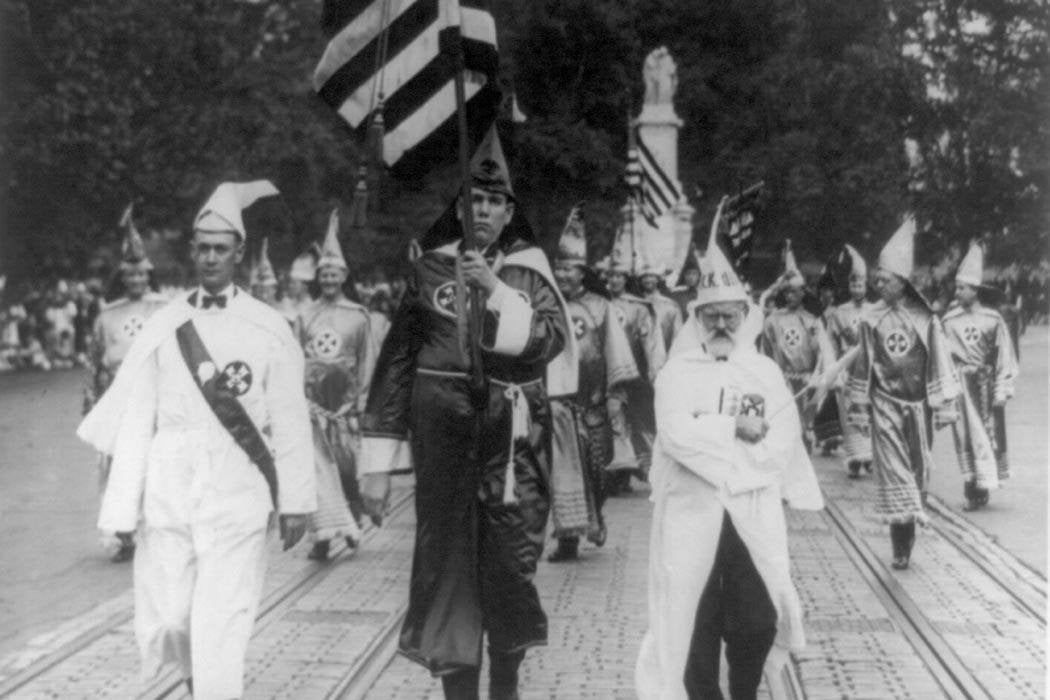When Donald Trump did not denounce the Ku Klux Klan outright during a late-February interview on CNN, it suggested a level of naked racism rarely seen in modern American politics. But it’s easy to forget just how big and prominent the KKK used to be.
In a 1965 paper, Charles C. Alexander considered the version of the Klan that existed in the early 1920s. At the time, it was more than just a terrorist organization: it was also a multi-million-dollar business enterprise.
Alexander writes that former Methodist-Episcopal minister William Joseph Simmons founded the “Invisible Empire, Knights of the Ku Klux Klan, Incorporated” in Georgia in 1915. Simmons called it a “living memorial” to the original KKK, which had fought Reconstruction in the post-Civil War South with lynchings and other forms of violence. Simmons insisted that the new Klan would be a respectable organization for patriotic white Protestant Americans. He adopted the title of “Imperial Wizard” and gave his subordinates monikers like “Kligrapp,” “Kludd,” and “Nighthawk.”
The Klan attracted a few thousand members in Georgia and Alabama over the following years, but it really took off in 1920, when Simmons hired two publicity agents, Edward Young Clarke and Elizabeth Tyler. Clarke and Tyler had more than 1,000 field organizers travel around southern and southwestern states “with instructions to play upon whatever prejudices—anti-Catholicism, anti-Semitism, racism, or moral zealotry—were most acute,” Alexander writes.
Where Simmons’s vision for the Klan was not particularly ideological, Young and Tyler harnessed aggressive patriotism, prejudice, and the fear of foreigners. Soon, Klansmen were burning crosses, threatening their enemies, and gaining power in local and state governments. Within 16 months, 90,000 to 100,000 men joined the KKK, bringing in $1.5 million in initiation fees and from the sales of robes, literature, and other products.
As membership continued to grow, Simmons arranged for the opening of a factory making Klan robes and other products, under the ownership of the KKK. The organization formed its own company to publish Klan literature and a newspaper. Clarke and Tyler opened a real estate business to buy and sell Klan properties in Atlanta, including a $45,000 ‘Imperial Palace” for Simmons.
By 1922, Simmons said the KKK was inducting 3,500 members and bringing in at least $10,000 to the national headquarters each day. Yet its financial operations were a mess. In December, a subordinate of Clarke and Tyler resigned, accusing them of fleecing the group.
Under pressure from others in the Klan who were interested in expanding the group’s political power, Simmons gave up the Imperial Wizard position. And in 1923, Clarke and Tyler left the organization.
Weekly Newsletter
Alexander writes that the new Imperial Wizard, Hiram W. Evans, seems to have stemmed the corruption while continuing growth, in part by letting local offices keep more of the money they brought in. By 1923, Simmons estimated the total income of all Klan organizational levels at $12 million.
The KKK declined in the late 1920s, before reemerging in opposition to the Civil Rights movement in the 1950s, but the story of its quick rise is a reminder of the ability of shrewd organizers to capitalize on bigotry.







